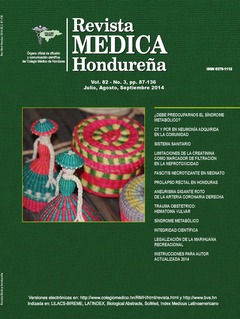Limitations of creatinine as a filtration marker in contrast-induced neprhotoxicity in patients undergoing cardiac catheterization
Keywords:
renal function, contrast media, contrast-induced nephrotoxicity, glomerular filtration rate, creatinineAbstract
Introduction: The study aim was to asses if the glomerular filtration rate (GFR) calculated by the Cockroft-Gault method offers better approaching than serum creatinine levels (CrS) for detecting contrast-induced nephropathy in patients (PS) exposed to contrast media. Method: 133 PS with basal CrS level up 1.2 mg/dL who underwent cardiac catheterization (CC) were enrolled into the study and CrS blood levels were measured before and 48 h after the procedure. Results: In basal settings, PS were distributed in two groups: Group I (GFR<60 mL/min, n=15) and Group II (GFR≥60 mL/min, n=118). When comparing each other, Group I PS shown higher CrS level (1.01 ± 0.14 vs 0.88 ± 0.18 mg/dL; P=0.007) and lower GFR (49.1 ± 6.7 vs 101.1 ± 29.9 mL/min; P<0.0001) than Group II; PS were old-aged (P=0.006), mostly female gender, lower weight (P<0.0001) and height. Forty eight hours after CC, 20.3% PS met NTIC criteria. Again, PS were stratified in two different groups: with nephrotoxicity (CPFR, n=27) and without nephrotoxicity (SPFR, n=106); in CPFR group the CrS raised from 0.80 ± 0.20 to 1.10 ± 0.23 mg/dL (P=0.0001) while GFR fell from 98.1 ± 46.0 to 69.8 ± 31.0 mL/min (P=0.0001). Conclusions: The GFR assessed by Cockcroft-Gault method was more efficient and faster than CrS levels to asses renal function before contrast media exposure, and allowed patients identification with normal CrS levels but with some degree of renal dysfunction (prevalence of 11.3%).
Downloads
106




